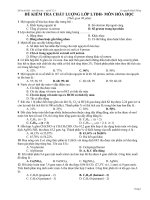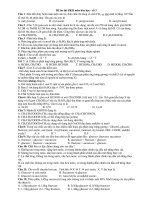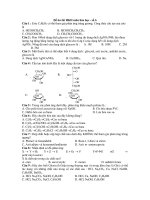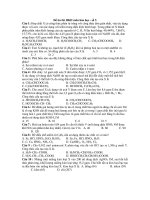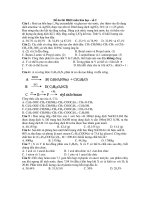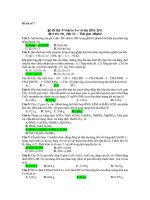Đề ôn thi thử môn hóa (561)
Bạn đang xem bản rút gọn của tài liệu. Xem và tải ngay bản đầy đủ của tài liệu tại đây (127.54 KB, 5 trang )
e1
References
1. Tynan MJ, Becker AE, Macartney FJ, Jiménez MQ, Shinebourne
EA, Anderson RH. Nomenclature and classification of congenital
heart disease. Br Heart J. 1979;41:544-553.
2. von Lüdinghausen M, Ohmachi N, Besch S, Mettenleiter A. Atrial
veins of the human heart. Clin Anat. 1995;8:169-189.
3. Anderson PAW. Immature myocardium. In: Moller JH, Neal WA,
eds. Fetal, Neonatal, and Infant Cardiac Disease. Norwalk, CT: Appleton & Lange; 1992.
4. Birk E. Myocardial receptors. In: Gluckman PD, Heymann MA,
eds. Pediatrics and Perinatology. The Scientific Basis. London: Edward
Arnold; 1996.
5. Friedman WF, et al. The intrinsic physiologic properties of the developing heart. In: Friedman WF, ed. Neonatal Heart Disease. New
York: Grune & Stratton; 1973.
6. Coleridge JCG, Coleridge HM. Chemoreflex regulation of the
heart. In: Berne RM, Sperelakis N, eds. Handbook of Physiology,
Section 2: The Cardiovascular System. Vol 1. The Heart. Bethesda,
MD: American Physiological Society; 2001.
7. Clyman RI. Developmental physiology of the ductus arteriosus. In:
Polin Long WA, ed. Fetal and Neonatal Cardiology. New York: WB
Saunders; 1989.
8. Clyman RI. Medical treatment of the ductus arteriosus in premature
infants. In: Polin Long WA, ed. Fetal and Neonatal Cardiology. New
York: WB Saunders; 1989.
9. Clyman RI. Patent ductus arteriosus in the premature infant. In:
Avery ME, ed. Diseases of the Newborn. Philadelphia: WB Saunders; 1998.
10. Coceani F, Kelsey L. Endothelin-1 release from lamb ductus arteriosus: relevance to postnatal closure of the vessel. Can J Physiol Pharmacol. 1991;69:218-221.
11. Michelakis ED, Rebeyka I, Wu X, et al. O2 sensing in the human
ductus arteriosus: regulation of voltage-gated K1 channels in
smooth muscle cells by a mitochondrial redox sensor. Circ Res.
2002;91:478-486.
12. Reeve HL, Tolarova S, Nelson DP, Archer S, Weir EK. Redox control of oxygen sensing in the rabbit ductus arteriosus. J Physiol.
2001;533:253-261.
13. Tristani-Firouzi M, Reeve HL, Tolarova S, Weir EK, Archer SL.
Oxygen-induced constriction of rabbit ductus arteriosus occurs via
inhibition of a 4-aminopyridine-, voltage-sensitive potassium channel. J Clin Invest. 1996;98:1959-1965.
14. Clyman RI, Waleh N, Black SM, Riemer RK, Mauray F, Chen YQ.
Regulation of ductus arteriosus patency by nitric oxide in fetal
lambs: the role of gestation, oxygen tension, and vasa vasorum. Pediatr Res. 1998;43:633-644.
15. Clyman RI, Chan CY, Mauray F, et al. Permanent anatomic closure
of the ductus arteriosus in newborn baboons: the roles of postnatal
constriction, hypoxia, and gestation. Pediatr Res. 1999;45:19-29.
16. Korecky B, Rakusan K. Normal and hypertrophic growth of the rat
heart: changes in cell dimensions and number. Am J Physiol. 1978;
234:H123-H128.
17. Streeter Jr DD, Hanna WT. Engineering mechanics for successive
states in canine left ventricular myocardium. 11. Fiber angle and
sarcomere length. Circ Res. 1973;33:656-664.
18. Torrent-Guasp F, Buckberg GD, Clemente C, Cox JL, Coghlan HC,
Gharib M. The structure and function of the helical heart and its
buttress wrapping. I. The normal macroscopic structure of the heart.
Semin Thorac Cardiovasc Surg. 2001;13:301-319.
19. Athanasuleas CL, Buckberg GD, Menicanti L, Gharib M, RESTORE Group. Optimizing ventricular shape in anterior restoration. Semin Thorac Cardiovasc Surg. 2001;13:459-467.
20. Kanno S, Saffitz JE. The role of myocardial gap junctions in electrical conduction and arrhythmogenesis. Cardiovasc Pathol. 2001;10:
169-177.
21. van Veen AA, van Rijen HV, Opthof T. Cardiac gap junction channels: modulation of expression and channel properties. Cardiovasc
Res. 2001;51:217-229.
22. Yeager M, Nicholson BJ. Structure of gap junction intercellular
channels. Curr Opin Struct Biol. 1996;6:183-192.
23. Hein S, Kostin S, Heling A, Maeno Y, Schaper J. The role of the
cytoskeleton in heart failure. Cardiovasc Res. 2000;45:273-278.
24. Chidsey CA. Calcium metabolism in the normal and failing heart.
In: Braunwald E, ed. The Myocardium: Failure and Infarction. New
York: HP Publishing; 1974.
25. Shroff SG, et al. Mechanical and energetic behavior of the intact left
ventricle. In: Fozzard HA, et al., eds. The Heart and Cardiovascular
System: Scientific Foundations. New York: Raven Press; 1991.
26. Sonnenblick EH, Spiro D, Spotnitz HM. The ultrastructural basis of
Starling’s law of the heart. The role of the sarcomere in determining
ventricular size and stroke volume. Am Heart J. 1964;68:336-346.
27. Katz AM. Contractile proteins in normal and failing myocardium.
In: Braunwald E, ed. The Myocardium: Failure and Infarction. New
York: HP Publishing; 1974.
28. Moolman-Smook J, Flashman E, de Lange W, et al. Identification of
novel interactions between domains of myosin binding protein-C
that are modulated by hypertrophic cardiomyopathy missense mutations. Circ Res. 2002;91:704-711.
29. Granzier H, Labeit S. Cardiac titin: an adjustable multi-functional
spring. J Physiol. 2002;541:335-342.
30. Le Guennec JY, Cazorla O, Lacampagne A, Vassort G. Is titin the
length sensor in cardiac muscle? Physiological and physiopathological perspectives. Adv Exp Med Biol. 2000;481:337-348.
31. Tonino P, Kiss B, Strom J, et al. The giant protein titin regulates the
length of the striated muscle thick filament. Nat Commun.
2017;8:1041.
32. Herman DS, Lam L, Taylor MRG, et al. Truncations of titin causing
dilated cardiomyopathy. N Engl J Med. 2012;366:619-628.
33. LeWinter MM, Granzier HL. Cardiac titin and heart disease. J Cardiovasc Pharmacol. 2014;63:207-212.
34. Muller FU, Kirchhefer U, Begrow F, Reinke U, Neumann J, Schmitz
W. Junctional sarcoplasmic reticulum transmembrane proteins in
the heart. Basic Res Cardiol. 2002;97(suppl 1):I52-I55.
35. Bristow M. Of phospholamban, mice, and humans with heart failure. Circulation. 2001;103:787-788.
36. Chu G, Kranias EG. Functional interplay between dual site phospholamban phosphorylation: insights from genetically altered mouse
models. Basic Res Cardiol. 2002;97(suppl 1):I43-I48.
37. Frank K, Kranias EG. Phospholamban and cardiac contractility. Ann
Med. 2000;32:572-578.
38. Schmidt AG, Edes I, Kranias EG. Phospholamban: a promising
therapeutic target in heart failure? Cardiovasc Drugs Ther.
2001;15:387-396.
39. Munch G, Bölck B, Karczewski P, Schwinger RH. Evidence for calcineurin-mediated regulation of SERCA 2a activity in human myocardium. J Mol Cell Cardiol. 2002;34:321-334.
40. Frank KF, Bölck B, Brixius K, Kranias EG, Schwinger RH. Modulation of SERCA: implications for the failing human heart. Basic Res
Cardiol. 2002;97(suppl 1):I72-I78.
41. Pieske B, Maier LS, Schmidt-Schweda S. Sarcoplasmic reticulum
Ca21 load in human heart failure. Basic Res Cardiol. 2002;97(suppl
1):I63-I71.
42. Wu LL, Tang C, Dong LW, Liu MS. Altered phospholamban-calcium ATPase interaction in cardiac sarcoplasmic reticulum during
the progression of sepsis. Shock. 2002;17:389-393.
43. Lennon NJ, Ohlendieck K. Impaired Ca21-sequestration in dilated
cardiomyopathy (review). Int J Mol Med. 2001;7:131-141.
44. Napolitano C, Priori SG, Bloise R. Catecholaminergic polymorphic
ventricular tachycardia. In: Adam MP, Ardinger HH, Pagon RA, et
al., eds. SourceGeneReviews® [Internet]. Seattle, WA: University of
Washington, Seattle; 2016.
45. Anderson PAW. Developmental cardiac physiology and myocardial
function. In: Moller JH, Hoffman JIE, eds. Pediatric Cardiovascular
Medicine. New York: Churchill Livingstone; 2000.
46. Gregorio CC, Antin PB. To the heart of myofibril assembly. Trends
Cell Biol. 2000;10:355-362.
e2
47. Squire JM. Architecture and function in the muscle sarcomere. Curr
Opin Struct Biol. 1997;7:247-257.
48. Capetanaki Y, Milner DJ. Desmin cytoskeleton in muscle integrity
and function. Subcell Biochem. 1998;31:463-495.
49. Capetanaki Y, Milner DJ, Weitzer G. Desmin in muscle formation
and maintenance: knockouts and consequences. Cell Struct Funct.
1997;22:103-116.
50. Stewart M. Intermediate filament structure and assembly. Curr Opin
Cell Biol. 1993;5:3-11.
51. Barth AI, Näthke IS, Nelson WJ. Cadherins, catenins and APC
protein: interplay between cytoskeletal complexes and signaling
pathways. Curr Opin Cell Biol. 1997;9:683-690.
52. Ben-Ze’ev A, Geiger B. Differential molecular interactions of betacatenin and plakoglobin in adhesion, signaling and cancer. Curr
Opin Cell Biol. 1998;10:629-639.
53. Burridge K, Chrzanowska-Wodnicka M. Focal adhesions, contractility, and signaling. Annu Rev Cell Dev Biol. 1996;12:463-518.
54. Towbin JA. The role of cytoskeletal proteins in cardiomyopathies.
Curr Opin Cell Biol. 1998;10:131-139.
55. Towbin JA, Bowles NE. Molecular genetics of left ventricular dysfunction. Curr Mol Med. 2001;1:81-90.
56. Towbin JA, Bowles NE. The failing heart. Nature. 2002;415:227-233.
57. Borg TK, Ranson WF, Moslehy FA, Caulfield JB. Structural basis of
ventricular stiffness. Lab Invest. 1981;44:49-54.
58. Robinson TF, Cohen-Gould L, Factor SM, Eghbali M, Blumenfeld
OO. Structure and function of connective tissue in cardiac muscle:
collagen types I and III in endomysial struts and pericellular fibers.
Scanning Microsc. 1988;2:1005-1015.
59. Robinson TF, Geraci MA, Sonnenblick EH, Factor SM. Coiled
perimysial fibers of papillary muscle in rat heart: morphology, distribution, and changes in configuration. Circ Res. 1988;63:577-592.
60. Zhao MJ, Zhang H, Robinson TF, Factor SM, Sonnenblick EH,
Eng C. Profound structural alterations of the extracellular collagen
matrix in postischemic dysfunctional (“stunned”) but viable myocardium. J Am Coll Cardiol. 1987;10:1322-1334.
61. Nassar R, Reedy MC, Anderson PA. Developmental changes in the
ultrastructure and sarcomere shortening of the isolated rabbit ventricular myocyte. Circ Res. 1987;61:465-483.
62. Terracio L, Gullberg D, Rubin K, Craig S, Borg TK. Expression of
collagen adhesion proteins and their association with the cytoskeleton in cardiac myocytes. Anat Rec. 1989;223:62-71.
63. Terracio L, Rubin K, Gullberg D, et al. Expression of collagen binding integrins during cardiac development and hypertrophy. Circ Res.
1991;68:734-744.
64. Bristow JD. Cardiac and myocardial structure and myocardial cellular
and molecular function. In: Gluckman PD, Heymann MA, eds. Pediatrics and Perinatology. The Scientific Basis. London: Edward Arnold; 1996.
65. Fabiato A. Calcium release in skinned cardiac cells: variations with
species, tissues, and development. Fed Proc. 1982;41:2238-2244.
66. Lakatta EG. Length modulation of myocardial performance: FrankStarling law of the heart. In: Fozzard HA, et al., eds. The Heart and Cardiovascular System: Scientific Foundations. New York: Raven Press; 1991.
67. Mahony L. Development of myocardial structure and function. In:
Emmanouilides GC, et al., eds. Heart Disease in Infants, Children,
and Adolescents, Including the Fetus and Young Adult. Baltimore, MD:
Williams & Wilkins; 1998.
68. Sonnenblick EH. Myocardial ultrastructure in the normal and the
failing heart. In: Braunwald E, ed. The Myocardium: Failure and Infarction. New York: HP Publishing; 1974.
69. Smith VE, Zile MR. Relaxation and diastolic properties of the heart.
In: Fozzard HA, et al., eds. The Heart and Cardiovascular System:
Scientific Foundations. New York: Raven Press; 1991.
70. Granzier HL, Irving TC. Passive tension in cardiac muscle: contribution of collagen, titin, microtubules, and intermediate filaments.
Biophys J. 1995;68:1027-1044.
71. Strobeck JE, Sonnenblick EH. Myocardial contractile properties and
ventricular performance. In: Fozzard HA, et al., eds. The Heart and
Cardiovascular System: Scientific Foundations. New York: Raven Press; 1991.
72. McCormack J, Gelband H, Villafañe J, Xu H, Stolfi A, Pickoff AS.
In vivo demonstration of maturational changes of the chronotropic
response to alpha-adrenergic stimulation. Pediatr Res. 1988;24:50-54.
73. Bristow MR, Ginsburg R, Umans V, et al. Beta 1- and beta 2-adrenergic-receptor subpopulations in nonfailing and failing human ventricular myocardium: coupling of both receptor subtypes to muscle
contraction and selective beta 1-receptor down-regulation in heart
failure. Circ Res. 1986;59:297-309.
74. Heilbrunn SM, Shah P, Bristow MR, Valantine HA, Ginsburg R,
Fowler MB. Increased beta-receptor density and improved hemodynamic response to catecholamine stimulation during long-term
metoprolol therapy in heart failure from dilated cardiomyopathy.
Circulation. 1989;79:483-490.
75. Stryer L, Bourne HR. G proteins: a family of signal transducers.
Annu Rev Cell Biol. 1986;2:391-419.
76. Xiao RP, Avdonin P, Zhou YY, et al. Coupling of beta2-adrenoceptor
to Gi proteins and its physiological relevance in murine cardiac
myocytes. Circ Res. 1999;84:43-52.
77. Communal C, Singh K, Sawyer DB, Colucci WS. Opposing effects
of beta(1)- and beta(2)-adrenergic receptors on cardiac myocyte
apoptosis: role of a pertussis toxin-sensitive G protein. Circulation.
1999;100:2210-2212.
78. Chesley A, Lundberg MS, Asai T, et al. The beta(2)-adrenergic receptor delivers an antiapoptotic signal to cardiac myocytes through
G(i)-dependent coupling to phosphatidylinositol 39-kinase. Circ Res.
2000;87:1172-1179.
79. Zaugg M, Xu W, Lucchinetti E, Shafiq SA, Jamali NZ, Siddiqui
MA. Beta-adrenergic receptor subtypes differentially affect apoptosis
in adult rat ventricular myocytes. Circulation. 2000;102:344-350.
80. Bristow MR. Mechanistic and clinical rationales for using betablockers in heart failure. J Card Fail. 2000;6:8-14.
81. Bristow MR, Roden RL, Lowes BD, Gilbert EM, Eichhorn EJ. The
role of third-generation beta-blocking agents in chronic heart failure.
Clin Cardiol. 1998;21:I3-I13.
82. Bruns LA, Canter CE. Should beta-blockers be used for the treatment of pediatric patients with chronic heart failure? Paediatr Drugs.
2002;4:771-778.
83. Fowler M. Beta-adrenergic blocking drugs in severe heart failure. Rev
Cardiovasc Med. 2002;3(suppl 3):S20-S26.
84. Kukin ML. Beta-blockers in chronic heart failure: considerations for
selecting an agent. Mayo Clin Proc. 2002;77:1199-1206.
85. Packer M, Fowler MB, Roecker EB, et al. Effect of carvedilol on the
morbidity of patients with severe chronic heart failure: results of the
carvedilol prospective randomized cumulative survival (COPERNICUS) study. Circulation. 2002;106:2194-2199.
86. Belge C, Hammond J, Dubois-Deruy E, et al. Enhanced expression
of b3-adrenoceptors in cardiac myocytes attenuates neurohormoneinduced hypertrophic remodeling through nitric oxide synthase.
Circulation. 2014;129:451-462.
87. Cannavo A, Koch WJ. Targeting b3-Adrenergic Receptors in the
Heart: Selective Agonism and b-Blockade. J Cardiovasc Pharmacol.
2017;69:71-78.
88. Artman M, Kithas PA, Wike JS, Strada SJ. Inotropic responses
change during postnatal maturation in rabbit. Am J Physiol.
1988;255:H335-H342.
89. Hoffman TM, Wernovsky G, Atz AM, et al. Efficacy and safety of
milrinone in preventing low cardiac output syndrome in infants and
children after corrective surgery for congenital heart disease. Circulation. 2003;107:996-1002.
90. Bailey JM, Hoffman TM, Wessel DL, et al. A population pharmacokinetic analysis of milrinone in pediatric patients after cardiac surgery. J Pharmacokinet Pharmacodyn. 2004;31:43-59.
91. Zuppa AF, Nicolson SC, Adamson PC, et al. Population pharmacokinetics of milrinone in neonates with hypoplastic left heart syndrome
undergoing stage I reconstruction. Anesth Analg. 2006;102:1062-1069.
92. Glantz SA, Misbach GA, Moores WY, et al. The pericardium substantially affects the left ventricular diastolic pressure-volume relationship in the dog. Circ Res. 1978;42:433-441.
e3
93. Misky I. Factors which affect the diastolic pressure-volume curve.
Circ Res. 1979;44:592-595.
94. Tyberg JV, Belenkie I, Manyari DE, Smith ER. Ventricular interaction and venous capacitance modulate left ventricular preload. Can
J Cardiol. 1996;12:1058-1064.
95. Tyberg JV, Misbach GA, Glantz SA, Moores WY, Parmley WW. A
mechanism for shifts in the diastolic, left ventricular, pressure-volume curve: the role of the pericardium. Eur J Cardiol.
1978;7(suppl):163-175.
96. Ross Jr J. Afterload mismatch and preload reserve: a conceptual
framework for the analysis of ventricular function. Prog Cardiovasc
Dis. 1976;18:255-264.
97. Ross Jr J. Mechanisms of cardiac contraction. What roles for preload, afterload and inotropic state in heart failure? Eur Heart J.
1983;4(suppl A):19-28.
98. Carabello BA, Spann JF. The uses and limitations of end-systolic
indexes of left ventricular function. Circulation. 1984;69:1058-1064.
99. McHale PA, Greenfield Jr JC. Evaluation of several geometric
models for estimation of left ventricular circumferential wall stress.
Circ Res. 1973;33:303-312.
100. Grossman W, Jones D, McLaurin LP. Wall stress and patterns of
hypertrophy in the human left ventricle. J Clin Invest. 1975;56:56-64.
101. Glower DD, Spratt JA, Snow ND, et al. Linearity of the FrankStarling relationship in the intact heart: the concept of preload recruitable stroke work. Circulation. 1985;71:994-1009.
102. Goldsmith SR. Congestive heart failure: potential role of arginine
vasopressin antagonists in the therapy of heart failure. Congest
Heart Fail. 2002;8:251-256.
103. Schwinger RH, Böhm M, Koch A, et al. The failing human heart
is unable to use the Frank-Starling mechanism. Circ Res.
1994;74:959-969.
104. Anderson PA, Rankin JS, Arentzen CE, Anderson RW, Johnson
EA. Evaluation of the force-frequency relationship as a descriptor
of the inotropic state of canine left ventricular myocardium. Circ
Res. 1976;39:832-839.
105. Pidgeon J, Lab M, Seed A, et al. The contractile state of cat and
dog heart in relation to the interval between beats. Circ Res. 1980;47:
559-567.
106. Seed WA, Noble MI, Walker JM, et al. Relationships between beatto-beat interval and the strength of contraction in the healthy and
diseased human heart. Circulation. 1984;70:799-805.
107. Mulieri LA, Hasenfuss G, Leavitt B, Allen PD, Alpert NR. Altered
myocardial force-frequency relation in human heart failure. Circulation. 1992;85:1743-1750.
108. Hasenfuss G, Holubarsch C, Hermann HP, Astheimer K, Pieske B,
Just H. Influence of the force-frequency relationship on haemodynamics and left ventricular function in patients with non-failing
hearts and in patients with dilated cardiomyopathy. Eur Heart J.
1994;15:164-170.
109. Sagawa K. The ventricular pressure-volume diagram revisited. Circ
Res. 1978;43:677-687.
110. Sagawa K. The end-systolic pressure-volume relation of the ventricle:
definition, modifications and clinical use. Circulation. 1981;63:
1223-1227.
111. Suga H. Ventricular energetics. Physiol Rev. 1990;70:247-277.
112. Redington AN, Gray HH, Hodson ME, Rigby ML, Oldershaw PJ.
Characterisation of the normal right ventricular pressure-volume
relation by biplane angiography and simultaneous micromanometer pressure measurements. Br Heart J. 1988;59:23-30.
113. Redington AN, Rigby ML, Shinebourne EA, Oldershaw PJ.
Changes in the pressure-volume relation of the right ventricle when
its loading conditions are modified. Br Heart J. 1990;63:45-49.
114. Matthay RA, Arroliga AC, Wiedemann HP, Schulman DS, Mahler DA.
Right ventricular function at rest and during exercise in chronic
obstructive pulmonary disease. Chest. 1992;101(suppl 5):255S-262S.
115. Parmley WW, Chuck L, Yeatman L. Comparative evaluation of the
specificity and sensitivity of isometric indices of contractility. Am J
Physiol. 1975;228:506-510.
116. Lakatta EG, Jewell BR. Length-dependent activation: its effect on
the length-tension relation in cat ventricular muscle. Circ Res.
1977;40:251-257.
117. Banerjee A, Brook MM, Klautz RJ, Teitel DF. Nonlinearity of the
left ventricular end-systolic wall stress-velocity of fiber shortening
relation in young pigs: a potential pitfall in its use as a single-beat
index of contractility. J Am Coll Cardiol. 1994;23:514-524.
118. Kass DA, Beyar R, Lankford E, Heard M, Maughan WL, Sagawa
K. Influence of contractile state on curvilinearity of in situ endsystolic pressure-volume relations. Circulation. 1989;79:167-178.
119. Krosl P, Abel FL. Problems with use of the end systolic pressurevolume slope as an indicator of left ventricular contractility: an alternate method. Shock. 1998;10:285-291.
120. Colan SD, Borow KM, Neumann A. Left ventricular end-systolic
wall stress-velocity of fiber shortening relation: a load-independent
index of myocardial contractility. J Am Coll Cardiol. 1984;4:
715-724.
121. Mertens L, Friedberg MK. Systolic ventricular function. In: Lai
WW, Mertens LL, Cohen MS, Geva T, eds. Echocardiography in
Pediatric and Congenital Heart Disease: From Fetus to Adult. 2nd ed.
West Sussex, UK: Wiley Blackwell; 2016:96-131.
122. Gaasch WH, et al. Diastolic properties of the left ventricle. In:
Levine HJ, Gaasch WH, eds. The Ventricle: Basic and Clinical Aspects. Boston: Martinus Nijhoff; 1985.
123. Kirk R, Dipchand AI, Rosenthal DN, et al. The International Society for Heart and Lung Transplantation Guidelines for the management of pediatric heart failure: Executive summary. J Heart
Lung Transplant. 2014;33:888-909.
124. Bers DM. Cardiac excitation-contraction coupling. Nature.
2002;415:198-205.
125. Frais MA, Bergman DW, Kingma I, Smiseth OA, Smith ER, Tyberg JV. The dependence of the time constant of left ventricular
isovolumic relaxation (tau) on pericardial pressure. Circulation.
1990;81:1071-1080.
126. Mawad W, Friedberg MK. The continuing challenge of evaluating
diastolic function by echocardiography in children: developing
concepts and newer modalities. Curr Opin Cardiol. 2017;32:
93-100.
127. Dragulescu A, Mertens L, Friedberg MK. Interpretation of left
ventricular diastolic dysfunction in children with cardiomyopathy
by echocardiography: problems and limitations. Circ Cardiovasc
Imaging. 2013;6:254-261.
128. Border WL, Syed AU, Michelfelder EC, et al. Impaired systemic
ventricular relaxation affects postoperative short-term outcome in
Fontan patients. J Thorac Cardiovasc Surg. 2003;126:1760-1764.
129. Smiseth OA, Frais MA, Junemann M, et al. Left and right ventricular diastolic function during acute pericardial tamponade. Clin
Physiol. 1991;11:61-71.
130. Tyberg JV, Taichman GC, Smith ER, Douglas NW, Smiseth OA,
Keon WJ. The relationship between pericardial pressure and right
atrial pressure: an intraoperative study. Circulation. 1986;73:
428-432.
131. Slinker BK, Glantz SA. End-systolic and end-diastolic ventricular
interaction. Am J Physiol. 1986;251:H1062-H1075.
132. Smiseth OA, Frais MA, Kingma I, et al. Assessment of pericardial
constraint: the relation between right ventricular filling pressure
and pericardial pressure measured after pericardiocentesis. J Am
Coll Cardiol. 1986;7:307-314.
133. Morgan BC, Guntheroth WG, Dillard DH. Relationship of pericardial to pleural pressure during quiet respiration and cardiac
tamponade. Circ Res. 1965;16:493-498.
134. Tyberg JV, Grant DA, Kingma I, et al. Effects of positive intrathoracic pressure on pulmonary and systemic hemodynamics. Respir
Physiol. 2000;119:171-179.
135. Naughton MT, Rahman MA, Hara K, Floras JS, Bradley TD. Effect of continuous positive airway pressure on intrathoracic and left
ventricular transmural pressures in patients with congestive heart
failure. Circulation. 1995;91:1725-1731.
e4
136. Santamore WP, Dell’Italia LJ. Ventricular interdependence: significant left ventricular contributions to right ventricular systolic function. Prog Cardiovasc Dis. 1998;40:289-308.
137. Weber KT, Janicki JS, Shroff S, Fishman AP. Contractile mechanics
and interaction of the right and left ventricles. Am J Cardiol.
1981;47:686-695.
138. Belenkie I, Dani R, Smith ER, Tyberg JV. The importance of pericardial constraint in experimental pulmonary embolism and volume loading. Am Heart J. 1992;123:733-742.
139. Belenkie I, Smith ER, Tyberg JV. Ventricular interaction: from
bench to bedside. Ann Med. 2001;33:236-241.
140. Penny DJ, Redington AN. Function of the left and right ventricles
and the interactions between them. Pediatr Crit Care Med.
2016;17:S112-S118.
141. Friedberg MK, Redington AN. Right versus left ventricular failure:
differences,
similarities,
and
interactions.
Circulation.
2014;129:1033-1044.
142. Damiano Jr RJ, La Follette Jr P, Cox JL, et al. Significant left ventricular contribution to right ventricular systolic function. Am J
Physiol. 1991;261:H1514-H1524.
143. Brookes C, Ravn H, White P, Moeldrup U, Oldershaw P, Redington A. Acute right ventricular dilatation in response to ischemia
significantly impairs left ventricular systolic performance. Circulation. 1999;100:761-767.
144. Vatner SF. Sympathetic mechanisms regulating myocardial contractility in conscious animals. In: Fozzard HA, et al., eds. The
Heart and Cardiovascular System: Scientific Foundations. New York:
Raven Press; 1991.
145. Mangoni ME, Nargeot J. Genesis and regulation of the heart automaticity. Physiol Rev. 2008;88:919-982.
146. Acker H. Chemoreceptor and baroreceptor control of perinatal
oxygen supply in different organs. In: Jones CT, ed. Research in
Perinatal Medicine. Fetal and Neonatal Development. Vol 7. Ithaca,
NY: Perinatology Press; 1988.
147. Hawkins J, Van Hare GF, Schmidt KG, Rudolph AM. Effects of
increasing afterload on left ventricular output in fetal lambs. Circ
Res. 1989;65:127-134.
148. Gilbert RD. Effects of afterload and baroreceptors on cardiac function in fetal sheep. J Dev Physiol. 1982;4:299-309.
149. Gilbert RD. Control and distribution of cardiac output in the fetus. In: Jones CT, ed. Research in Perinatal Medicine. Fetal and
Neonatal Development. Vol 7. Ithaca, NY: Perinatology Press; 1988.
150. Lister G, Walter TK, Versmold HT, Dallman PR, Rudolph AM.
Oxygen delivery in lambs: cardiovascular and hematologic development. Am J Physiol. 1979;237:H668-H675.
151. Breall JA, Rudolph AM, Heymann MA. Role of thyroid hormone
in postnatal circulatory and metabolic adjustments. J Clin Invest.
1984;73:1418-1424.
152. Klopfenstein HS, Rudolph AM. Postnatal changes in the circulation and responses to volume loading in sheep. Circ Res.
1978;42:839-845.
153. Teitel DF, Sidi D, Chin T, Brett C, Heymann MA, Rudolph AM.
Developmental changes in myocardial contractile reserve in the
lamb. Pediatr Res. 1985;19:948-955.
154. Van Hare GF, Hawkins JA, Schmidt KG, Rudolph AM. The effects
of increasing mean arterial pressure on left ventricular output in
newborn lambs. Circ Res. 1990;67:78-83.
155. Clyman RI, Teitel D, Padbury J, Roman C, Mauray F. The role of
beta-adrenoreceptor stimulation and contractile state in the preterm lamb’s response to altered ductus arteriosus patency. Pediatr
Res. 1988;23:316-322.
156. Chapman JB. Heat production. In: Drake-Holland A, Noble
MIM, eds. Cardiac Metabolism. Chichester, United Kingdom: John
Wiley & Sons; 1983.
157. Elzinga G. Cardiac oxygen consumption and the production of
heat and work. In: Drake-Holland AJ, Noble MIM, eds. Cardiac
Metabolism. Chichester, United Kingdom: John Wiley & Sons;
1983.
158. Gibbs CJ, Chapman JB. Cardiac energetics. In: Berne RM,
Sperelakis N, eds. Handbook of Physiology, Section 2, the Cardiovascular System. The Heart. Vol 1. Bethesda, MD: American Physiological Society; 2001.
159. Hoffman JIE. Coronary physiology. In: Garfield OB, ed. Current
Concepts in Cardiovascular Physiology. New York: Academic Press; 1990.
160. Kitamura K, Jorgensen CR, Gobel FL, Taylor HL, Wang Y. Hemodynamic correlates of myocardial oxygen consumption during upright exercise. J Appl Physiol. 1972;32:516-522.
161. Opie LH. High energy phosphate compounds. In: Drake-Holland
AJ, Noble MTM, eds. Cardiac Metabolism. Chichester, United
Kingdom: John Wiley & Sons; 1983.
162. Opie LH. Fuels: carbohydrates and lipids. In: Opie LH, ed. The
Heart: Physiology and Metabolism. New York: Raven Press; 1991.
163. Rebouche CJ, Paulson DJ. Carnitine metabolism and function in
humans. Annu Rev Nutr. 1986;6:41-66.
164. Retter AS. Carnitine and its role in cardiovascular disease. Heart
Dis. 1999;1:108-113.
165. Sole MJ, Jeejeebhoy KN. Conditioned nutritional requirements:
therapeutic relevance to heart failure. Herz. 2002;27:174-178.
166. Gertz EW, Wisneski JA, Neese R, Houser A, Korte R, Bristow JD.
Myocardial lactate extraction: multi-determined metabolic function. Circulation. 1980;61:256-261.
167. Fisher DJ. Cardiac output and regional blood flows during hypoxaemia in unanaesthetized newborn lambs. J Dev Physiol. 1984;6:
485-494.
168. Fisher DJ. Increased regional myocardial blood flows and oxygen
deliveries during hypoxemia in lambs. Pediatr Res. 1984;18:602606.
169. Clark JB, Clark Jr CM. The growth and metabolism of the developing heart. In: Jones CT, ed. The Biochemical Development of the
Fetus and Neonate. Amsterdam: Elsevier Biomedical; 1982.
170. Sarnoff SJ, Mitchell JH. The control of the function of the heart.
In: Hamilton WE, Dow P, eds. Handbook of Physiology. Section 2:
Circulation. Vol 1. Washington, DC: American Physiological Society; 2001.
171. McDonald Jr RH, Taylor RR, Cingolani HE. Measurement of
myocardial developed tension and its relation to oxygen consumption. Am J Physiol. 1966;211:667-673.
172. Parmley WW, Tyberg JV. Determinants of myocardial oxygen demand. In: Yu P, Goodwin JF, eds. Progress in Cardiology. Philadelphia: Lea & Febiger; 1988.
173. Strauer BE. Myocardial oxygen consumption in chronic heart disease: role of wall stress, hypertrophy and coronary reserve. Am J
Cardiol. 1979;44:730-740.
174. Taylor RR. Myocardial oxygen consumption, left ventricular fibre
shortening and wall tension. Cardiovasc Res. 1967;1:219.
175. Graham Jr TP, Covell JW, Sonnenblick EH, Ross Jr J, Braunwald
E. Control of myocardial oxygen consumption: relative influence
of contractile state and tension development. J Clin Invest.
1968;47:375-385.
176. Rooke GA, Feigl EO. Work as a correlate of canine left ventricular
oxygen consumption, and the problem of catecholamine oxygen
wasting. Circ Res. 1982;50:273-286.
177. Vinten-Johansen J, Duncan HW, Finkenberg JG, et al. Prediction
of myocardial O2 requirements by indirect indices. Am J Physiol.
1982;243:H862-H868.
178. Weber KT, Janicki JS. Myocardial oxygen consumption: the role of
wall force and shortening. Am J Physiol. 1977;233:H421-H430.
179. Weber KT, Janicki JS. Interdependence of cardiac function, coronary
flow, and oxygen extraction. Am J Physiol. 1978;235:H784-H793.
180. Hata K, Goto Y, Kawaguchi O, et al. Hypercapnic acidosis increases oxygen cost of contractility in the dog left ventricle. Am J
Physiol. 1994;266:H730-H740.
181. Hata K, Takasago T, Saeki A, Nishioka T, Goto Y. Stunned myocardium after rapid correction of acidosis. Increased oxygen cost of
contractility and the role of the Na(1)-H1 exchange system. Circ
Res. 1994;74:794-805.
e5
182. Suga H. Paul Dudley White International Lecture: cardiac performance as viewed through the pressure-volume window. Jpn Heart J.
1994;35:263-280.
183. Suga H, Goto Y, Yasumura Y, et al. O2 consumption of dog heart
under decreased coronary perfusion and propranolol. Am J Physiol.
1988;254:H292-H303.
184. Suga H, Hayashi T, Shirahata M, Suehiro S, Hisano R. Regression
of cardiac oxygen consumption on ventricular pressure-volume area
in dog. Am J Physiol. 1981;240:H320-H325.
185. Suga H, Hisano R, Goto Y, Yamada O, Igarashi Y. Effect of positive
inotropic agents on the relation between oxygen consumption and
systolic pressure volume area in canine left ventricle. Circ Res.
1983;53:306-318.
186. Hoffman JIE. Transmural myocardial perfusion. Prog Cardiovasc
Dis. 1987;29:429.
187. Hoffinan JI, Buckberg GD. The myocardial supply:demand ratio—
a critical review. Am J Cardiol. 1978;41:327-332.
188. Brazier J, Cooper N, Buckberg G. The adequacy of subendocardial
oxygen delivery: the interaction of determinants of flow, arterial
oxygen content and myocardial oxygen need. Circulation. 1974;
49:968-977.
189. Barnard RJ, MacAlpin R, Kattus AA, Buckberg GD. Ischemic response to sudden strenuous exercise in healthy men. Circulation.
1973;48:936-942.
190. Hearse DJ. Myocardial ischaemia: can we agree on a definition for
the 21st century? Cardiovasc Res. 1994;28:1737-1744.
191. Reimer KA, Jennings RB, et al. Myocardial ischemia, hypoxia, and
infarction. In: Fozzard HA, ed. The Heart and Cardiovascular System: Scientific Foundations. New York: Raven Press; 1991.
192. Canty Jr JM. Coronary pressure-function and steady-state pressure-flow relations during autoregulation in the unanesthetized
dog. Circ Res. 1988;63:821-836.
193. Gallagher KP, Kumada T, Koziol JA, et al. Significance of regional
wall thickening abnormalities relative to transmural myocardial
perfusion in anesthetized dogs. Circulation. 1980;62:1266-1274.
194. Vatner SF. Correlation between acute reductions in myocardial
blood flow and function in conscious dogs. Circ Res. 1980;47:
201-207.
195. Cooper HA, Braunwald E. Clinical importance of stunned and
hibernating myocardium. Coron Artery Dis. 2001;12:387-392.
196. Kern KB. Postresuscitation myocardial dysfunction. Cardiol Clin.
2002;20:89-101.
197. Kloner RA, Arimie RB, Kay GL, et al. Evidence for stunned
myocardium in humans: a 2001 update. Coron Artery Dis. 2001;12:
349-356.
198. Lüss H, Schäfers M, Neumann J, et al. Biochemical mechanisms of
hibernation and stunning in the human heart. Cardiovasc Res.
2002;56:411-421.
199. Kato R, Foex P. Myocardial protection by anesthetic agents against
ischemia-reperfusion injury: an update for anesthesiologists. Can J
Anaesth. 2002;49:777-791.
200. Tennyson H, Kern KB, Hilwig RW, Berg RA, Ewy GA. Treatment
of post resuscitation myocardial dysfunction: aortic counterpulsation versus dobutamine. Resuscitation. 2002;54:69-75.
201. Canty Jr JM, Fallavollita JA. Lessons from experimental models of
hibernating myocardium. Coron Artery Dis. 2001;12:371-380.
202. Heusch G, Schulz R. The biology of myocardial hibernation.
Trends Cardiovasc Med. 2000;10:108-114.
203. Heusch G, Schulz R. Hibernating myocardium: new answers, still
more questions! Circ Res. 2002;91:863-865.
204. Mari C, Strauss WH. Detection and characterization of hibernating myocardium. Nucl Med Commun. 2002;23:311-322.
205. Barlow CH, Harken AH, Chance B. Evaluation of cardiac ischemia
by NADH fluoroescence photography. Ann Surg. 1977;186:
737-740.
206. Wolinsky H, Glagov S. Comparison of abdominal and thoracic
aortic medial structure in mammals. Deviation of man from the
usual pattern. Circ Res. 1969;25:677-686.
207. Buga GM, Ignarro LJ. Vascular endothelium and smooth muscle
function. In: Gluckman PD, Heymann MA, eds. Pediatrics and
Perinatology. The Scientific Basis. London: Edward Arnold; 1996.
208. Stenmark KR, Weiser MC. Vascular development and function. In:
Gluckman PD, Heymann MA, eds. Pediatrics and Perinatology. The
Scientific Basis. London: Edward Arnold; 1996.
209. Springer TA. Traffic signals on endothelium for lymphocyte recirculation and leukocyte emigration. Annu Rev Physiol. 1995;57:827-872.
210. Andrews M, Massicotte P. Hemostasis. In: Gluckman PD, Heymann MA, eds. Pediatrics and Perinatology. The Scientific Basis.
London: Edward Arnold; 1996.
211. Friedman MH, Fry DL. Arterial permeability dynamics and vascular
disease. Atherosclerosis. 1993;104:189-194.
212. Fry DL. Acute vascular endothelial changes associated with increased
blood velocity gradients. Circ Res. 1968;22:165-197.
213. Franco-Cereceda A, Gennari C, Nami R, et al. Cardiovascular effects
of calcitonin gene-related peptides I and II in man. Circ Res. 1987;60:
393-397.
214. Beaulieu P, Lambert C. Peptidic regulation of heart rate and interactions with the autonomic nervous system. Cardiovasc Res. 1998;
37:578-585.
215. DiPette DJ, Schwarzenberger K, Kerr N, Holland OB. Systemic
and regional hemodynamic effects of calcitonin gene-related peptide.
Hypertension. 1987;9:III142-III146.
216. Frase LL, Gaffney FA, Lane LD, et al. Cardiovascular effects of
vasoactive intestinal peptide in healthy subjects. Am J Cardiol. 1987;
60:1356-1361.
217. Gangula PR, Zhao H, Supowit SC, et al. Increased blood pressure
in alpha-calcitonin gene-related peptide/calcitonin gene knockout
mice. Hypertension. 2000;35:470-475.
218. Hagner S, Stahl U, Knoblauch B, McGregor GP, Lang RE. Calcitonin receptor-like receptor: identification and distribution in human peripheral tissues. Cell Tissue Res. 2002;310:41-50.
219. Henning RJ, Sawmiller DR. Vasoactive intestinal peptide: cardiovascular effects. Cardiovasc Res. 2001;49:27-37.
220. Mione MC, Ralevic V, Burnstock G. Peptides and vasomotor
mechanisms. Pharmacol Ther. 1990;46:429-468.
221. Onuoha GN, Alpar EK, Chukwulobelu R, Nicholls DP. Distributions of VIP, substance P, neurokinin A and neurotensin in rat heart:
an immunocytochemical study. Neuropeptides. 1999;33:19-25.
222. Preibisz JJ. Calcitonin gene-related peptide and regulation of human cardiovascular homeostasis. Am J Hypertens. 1993;6:434-450.
223. Tamburino G, Malatino LS. The vasoactive peptidergic system.
Ann Ital Med Int. 1994;9:88-91.
224. Wang BC, Bie P, Leadley Jr RJ, Goetz KL. Cardiovascular effects of
calcitonin gene-related peptide in conscious dogs. Am J Physiol.
1989;257:R726-R731.
225. Wharton J, Gulbenkian S. Peptides in the mammalian cardiovascular system. Experientia. 1987;43:821-832.
226. Furness JB, Costa M, Papka RE, Della NG, Murphy R. Neuropeptides contained in peripheral cardiovascular nerves. Clin Exp Hypertens A. 1984;6:91-106.
227. Ganong WF. Origin of the angiotensin I1 secreted by cells. Proc Soc
Exp Biol Med. 1994;205:213-219.
228. Muller DN, Luft FC. The renin-angiotensin system in the vessel
wall. Basic Res Cardiol. 1998;93:7-14.
229. Burlew BS, Weber KT. Connective tissue and the heart. Functional
significance and regulatory mechanisms. Cardiol Clin. 2000;18:435-442.
230. Dzau VJ, Bernstein K, Celermajer D, et al. Pathophysiologic and
therapeutic importance of tissue ACE: a consensus report. Cardiovasc Drugs Ther. 2002;16:149-160.
231. Unger T. The role of the renin-angiotensin system in the development of cardiovascular disease. Am J Cardiol. 2002;89(2A):3A-9A.
232. Usui M, Egashira K, Tomita H, et al. Important role of local angiotensin II activity mediated via type 1 receptor in the pathogenesis
of cardiovascular inflammatory changes induced by chronic blockade of nitric oxide synthesis in rats. Circulation. 2000;101:
305-310.

